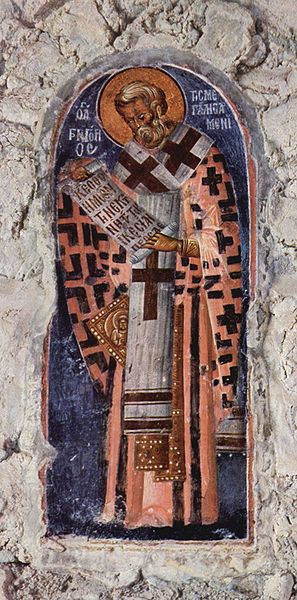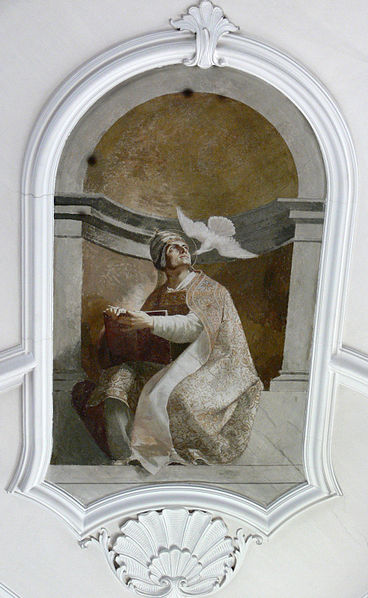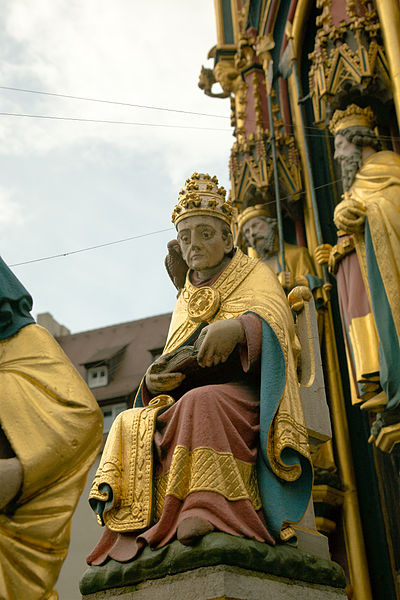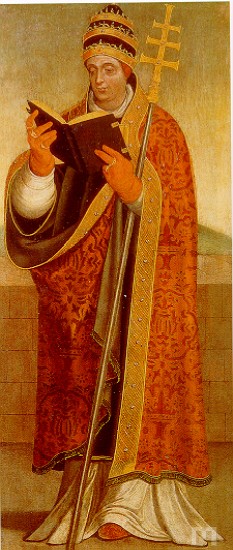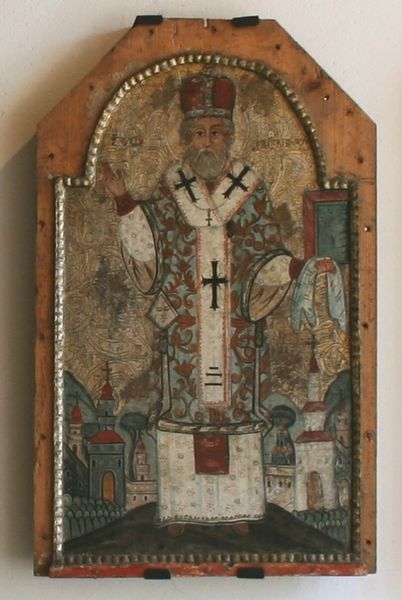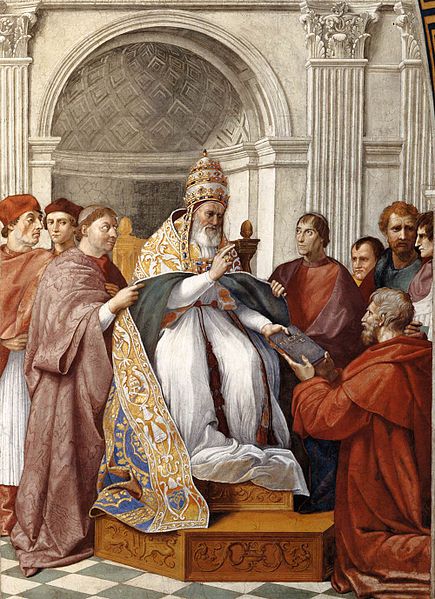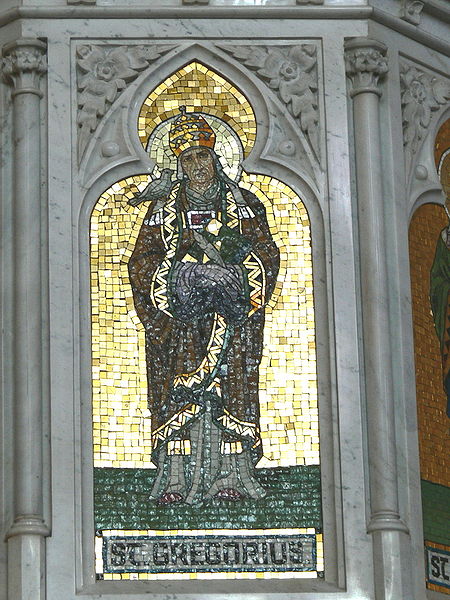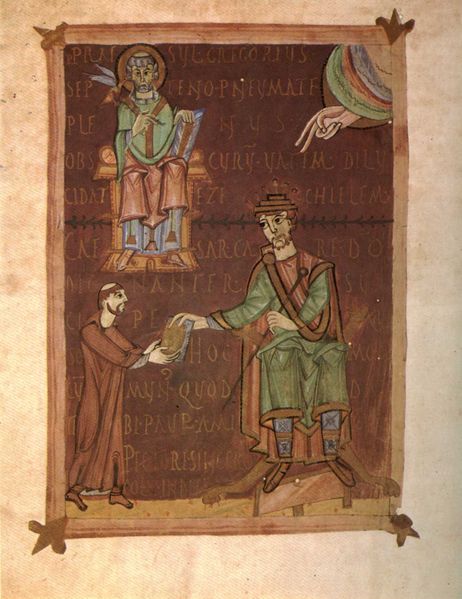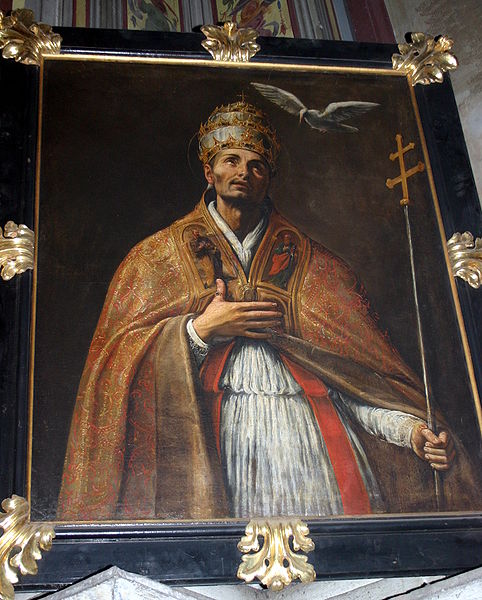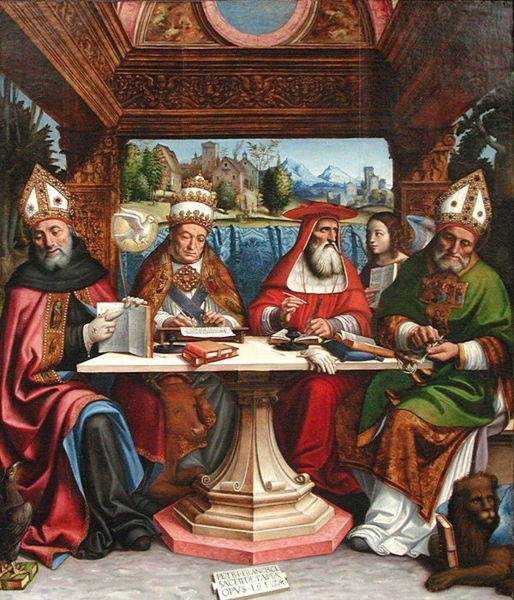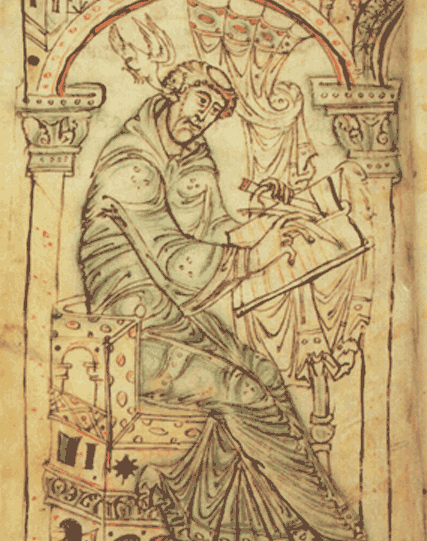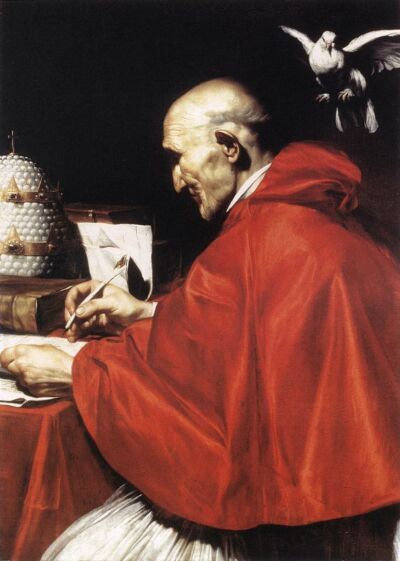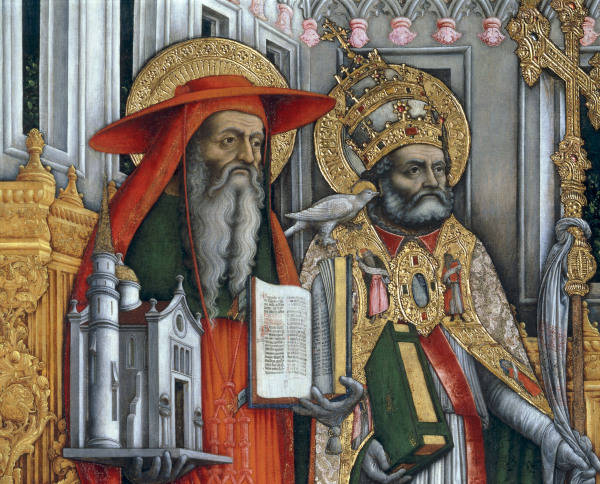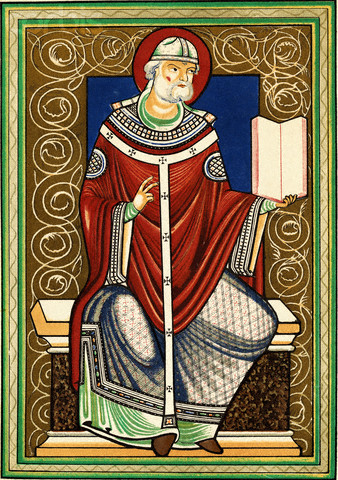<Back to Index>
- Pope Gregory I, 540
PAGE SPONSOR
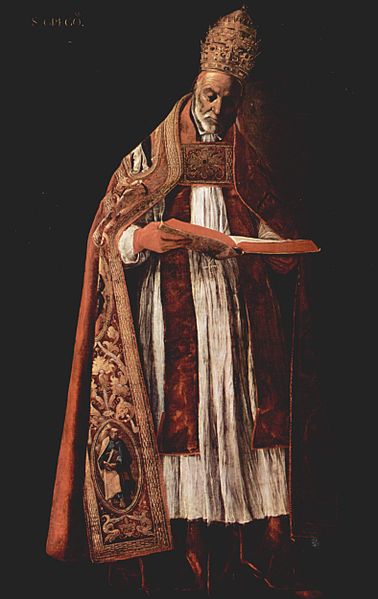
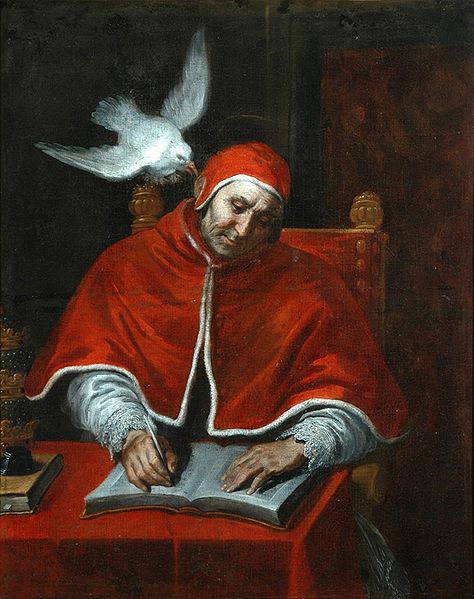
Pope Gregory I (Latin: Gregorius I) (c. 540 – 12 March 604), better known in English as Gregory the Great, was pope from 3 September 590 until his death. Gregory is well known for his writings, which were more prolific than those of any of his predecessors as pope.
Throughout
the Middle Ages he was known as “the Father of Christian Worship”
because of his exceptional efforts in revising the Roman worship of his
day. He is also known as St. Gregory the Dialogist in Eastern Orthodoxy because of his Dialogues.
For this reason, English translations of Orthodox texts will sometimes
list him as "Gregory Dialogus". He was the first of the popes to come
from a monastic background. Gregory is a Doctor of the Church and one of the Latin Fathers. He is considered a saint in the Roman Catholic Church, Eastern Orthodox Church, Anglican Communion, and some Lutheran churches. Immediately after his death, Gregory was canonized by popular acclaim. John Calvin admired Gregory and declared in his Institutes that Gregory was the last good pope. He is the patron saint of musicians, singers, students, and teachers.
The exact date of Gregory's birth is uncertain, but is usually estimated to be around the year 540, in the city of Rome. His parents named him Gregorius, which according to Aelfric in An Homily on the Birth - Day of S. Gregory, "... is a Greek Name, which signifies in the Latin Tongue Vigilantius, that is in English, Watchful...." The medieval writers who give this etymology do not hesitate to apply it to the life of Gregory. Aelfric, for example, goes on: "He was very diligent in God's Commandments."
When Gregory was a child, Italy was retaken from the Goths by Justinian I, emperor of the Roman Empire ruling from Constantinople. The war was over by 552. An invasion of the Franks was defeated in 554. The Western Roman Empire had long since vanished in favor of the Gothic kings of Italy. After 554 there was peace in Italy and the appearance of restoration, except that the government now resided in Constantinople. Italy was still united into one country, "Rome" and still shared a common official language, the very last of classical Latin.
From 542 the so-called Plague of Justinian swept through the provinces of the empire, including Italy. The plague caused famine, panic, and sometimes rioting. In some parts of the country, over 1/3 of the population was wiped out or destroyed. This had heavy spiritual and emotional effects on the people of the Empire.
As the fighting had been mainly in the north, the young Gregorius probably saw little of it. Totila sacked and vacated Rome in 547, destroying most of its ancient population, but in 549 he invited those who were still alive to return to the empty and ruinous streets. It has been hypothesized that young Gregory and his parents, Gordianus and Silvia, retired during that intermission to Gordianus' Sicilian estates, to return in 549.
Gregory had been born into a wealthy noble Roman family with close connections to the church. The Lives in Latin use nobilis but they do not specify from what historical layer the term derives or identify the family. No connection to patrician families of the Roman Republic has been demonstrated. Gregory's great - great - grandfather had been Pope Felix III, but that pope was the nominee of the Gothic king, Theodoric. Gregory's election to the throne of St Peter made his family the most distinguished clerical dynasty of the period. The family owned and resided in a villa suburbana on the Caelian Hill, fronting the same street, now the Via di San Gregorio, with the former palaces of the Roman emperors on the Palatine Hill opposite. The north of the street runs into the Colosseum; the south, the Circus Maximus. In Gregory's day the ancient buildings were in ruins and were privately owned. Villas covered the area. Gregory's family also owned working estates in Sicily and around Rome.
Gregory's father, Gordianus, held the position of Regionarius in the Roman Church. Nothing further is known about the position. Gregory's mother, Silvia, was well born and had a married sister, Pateria, in Sicily. Gregory later had portraits done in fresco in their former home on the Caelian and these were described 300 years later by John the Deacon. Gordianus was tall with a long face and light eyes. He wore a beard. Silvia was tall, had a round face, blue eyes and a cheerful look. They had another son whose name and fate are unknown.
The monks of St. Andrew's (the ancestral home on the Caelian) had a portrait of Gregory made after his death, which John the Deacon also saw in the 9th century. He reports the picture of a man who was "rather bald" and had a "tawny" beard like his father's and a face that was intermediate in shape between his mother's and father's. The hair that he had on the sides was long and carefully curled. His nose was "thin and straight" and "slightly aquiline." "His forehead was high." He had thick, "subdivided" lips and a chin "of a comely prominence" and "beautiful hands."
Gregory was well educated, with Gregory of Tours reporting that "in grammar, dialectic and rhetoric ... he was second to none...." He wrote correct Latin but did not read or write Greek. He knew Latin authors, natural science, history, mathematics and music and had such a "fluency with imperial law" that he may have trained in law, it has been suggested, "as a preparation for a career in public life."
While his father lived, Gregory took part in Roman political life and at one point was Prefect of the City.
In
the modern era, Gregory is often depicted as a man at the border,
poised between the Roman and Germanic worlds, between East and West, and
above all, perhaps, between the ancient and medieval epochs.
“Gregory had a deep respect for the monastic life. He viewed being a monk as the 'ardent quest for the vision of our Creator. 'His
three paternal aunts were nuns renowned for their sanctity. However,
after the two eldest passed away after seeing a vision of their ancestor
Pope Felix, the youngest soon abandoned the religious life and married
the steward of her estate. Gregory's response to this family scandal was
“many are called but few are chosen." Gregory's mother Silvia herself is a saint. On his father's death, he converted his family villa suburbana, located on the Caelian Hill just opposite the Circus Maximus, into a monastery dedicated to the apostle Saint Andrew. After his death it was rededicated as San Gregorio Magno al Celio.
In his life of contemplation, Gregory concluded that “in that silence
of the heart, while we keep watch within through contemplation, we are
as if asleep to all things that are without." Gregory
was not always forgiving, or pleasant for that matter, even in his
monastic years. For example, a monk lying on his death bed confessed to
stealing three gold pieces. Gregory forced the monk to die friendless
and alone, then threw his body and coins on a manure heap to rot with a
curse, “Take your money with you to perdition”. Gregory believed that
punishment of sins can begin, even on one's deathbed. Eventually, Pope Pelagius II ordained him a deacon and solicited his help in trying to heal the schism of the Three Chapters in northern Italy. However, Italy was not healed until well after Gregory was gone.
In 579, Pelagius II chose Gregory as his apocrisiarius (ambassador to the imperial court in Constantinople). Gregory was part of the Roman delegation (both lay and clerical) that arrived in Constantinople in 578 to ask the emperor for military aid against the Lombards. With the Byzantine military focused on the East, these entreaties proved unsuccessful; in 584, Pelagius II wrote to Gregory as apocrisiarius, detailing the hardships that Rome was experiencing under the Lombards and asking him to ask Emperor Maurice to send a relief force. Maurice, however, had long ago determined to limit his efforts against the Lombards to intrigue and diplomacy, pitting the Franks against them. It soon became obvious to Gregory that the Byzantine emperors were unlikely to send such a force, given their more immediate difficulties with the Persians in the East and the Avars and Slavs to the North.
According to Ekonomou, "if Gregory's principle task was to plead Rome's cause before the emperor, there seems to have been little left for him to do once imperial policy toward Italy became evident. Papal representatives who pressed their claims with excessive vigor could quickly become a nuisance and find themselves excluded from the imperial presence altogether". Gregory had already drawn an imperial rebuke for his lengthy canonical writings on the subject of the legitimacy of John III Scholasticus, who had occupied the Patriarchate of Constantinople for twelve years prior to the return of Eutychius (who had been driven out by Justinian). Gregory turned himself to cultivating connections with the Byzantine elite of the city, where he became extremely popular with the city's upper class, "especially aristocratic women". Ekonomou surmises that "while Gregory may have become spiritual father to a large and important segment of Constantinople's aristocracy, this relationship did not significantly advance the interests of Rome before the emperor". Although the writings of John the Deacon claim that Gregory "labored diligently for the relief of Italy", there is no evidence that his tenure accomplished much towards any of the objectives of Pelagius II.
Gregory's
theological disputes with Patriarch Eutychius would leave a "bitter
taste for the theological speculation of the East" with Gregory that
continued to influence him well into his papacy. According
to Western sources, Gregory's very public debate with Eutychian
culminated in an exchange before Tiberius II where Gregory cited a
biblical passage ("Palpate et videte, quia spiritus carnem et ossa non habet, sicut me videtis habere")
in support of the view that Christ was corporeal and palpable after his
Resurrection; allegedly as a result of this exchange, Tiberius II
ordered Eutychian's writings burned. Ekonomou views this argument, though exaggerated in Western sources, as Gregory's "one achievement of an otherwise fruitless apokrisiariat". In reality, Gregory was forced to rely on Scripture because he could not read the untranslated Greek authoritative works. Gregory left Constantinople for Rome in 585, returning to his monastery on the Caelian Hill. Gregory was elected by acclamation to succeed Pelagius II in 590, when the latter died of the plague spreading through the city. Gregory was approved by an Imperial iussio from Constantinople the following September (as was the norm during the Byzantine Papacy).
Amid
all his burdens and anxieties, it seems that the Pope had never
forgotten the English slaves whom he had once seen in the Roman Forum. Pope
Gregory had strong convictions on missions. "Almighty God places good
men in authority that He may impart through them the gifts of His mercy
to their subjects. And this we find to be the case with the British over
whom you have been appointed to rule, that through the blessings
bestowed on you the blessings of heaven might be bestowed on your people
also.”
Although Gregory was resolved to retire into the monastic lifestyle of contemplation, he was unwillingly forced back into a world that, although he loved, he no longer wanted to be a part of. In texts of all genres, especially those produced in his first year as pope, Gregory bemoaned the burden of office and mourned the loss of the undisturbed life of prayer he had once enjoyed as monk. When he became Pope in 590, among his first acts was writing a series of letters disavowing any ambition to the throne of Peter and praising the contemplative life of the monks. At that time, for various reasons, the Holy See had not exerted effective leadership in the West since the pontificate of Gelasius I. The episcopacy in Gaul was drawn from the great territorial families, and identified with them: the parochial horizon of Gregory's contemporary, Gregory of Tours, may be considered typical; in Visigothic Spain the bishops had little contact with Rome; in Italy the territories which had de facto fallen under the administration of the papacy were beset by the violent Lombard dukes and the rivalry of the Jews in the Exarchate of Ravenna and in the south.
Gregory is credited with re-energizing the Church's missionary work among the barbarian peoples of northern Europe. He is most famous for sending a mission, often called the Gregorian mission, under Augustine of Canterbury, prior of Saint Andrew's, where he had perhaps succeeded Gregory, to evangelize the pagan Anglo - Saxons of England. The mission was successful, and it was from England that missionaries later set out for the Netherlands and Germany. The preaching of the true Catholic faith and the elimination of all deviations from it was a key element in Gregory's worldview, and it constituted one of the major continuing policies of his pontificate.
According to the Catholic Encyclopedia, he was declared a saint immediately after his death by "popular acclamation".
In his official documents, Gregory was the first to make extensive use of the term "Servant of the Servants of God" (servus servorum Dei) as a papal title, thus initiating a practice that was to be followed by most subsequent popes.
In letters, Gregory remarks that he moved the Pater Noster (Our Father) to immediately after the Roman Canon and immediately before the Fraction. This position is still maintained today in the Roman Liturgy. The pre-Gregorian position is evident in the Ambrosian Rite. Gregory added material to the Hanc Igitur of the Roman Canon and established the nine Kyries (a vestigial remnant of the litany which was originally at that place) at the beginning of Mass. He also reduced the role of deacons in the Roman Liturgy.
Sacramentaries directly influenced by Gregorian reforms are referred to as Sacrementaria Gregoriana. With the appearance of these sacramentaries, the Western liturgy begins to show a characteristic that distinguishes it from Eastern liturgical traditions. In contrast to the mostly invariable Eastern liturgical texts, Roman and other Western liturgies since this era have a number of prayers that change to reflect the feast or liturgical season; These variations are visible in the collects and prefaces as well as in the Roman Canon itself.
A
system of writing down reminders of chant melodies was probably devised
by monks around 800 to aid in unifying the church service throughout
the Frankish empire. Charlemagne brought cantors from the Papal chapel in Rome to instruct his clerics in the “authentic” liturgy. A program of propaganda spread the idea that the chant used in Rome came directly from Gregory the
Great, who had died two centuries earlier and was universally venerated.
Pictures were made to depict the dove of the Holy Spirit perched on
Gregory's shoulder, singing God's authentic form of chant into his ear.
This gave rise to calling the music "Gregorian chant". Gregorian chanting is a type of plainsong or plainchant.
Sometimes the establishment of the Gregorian Calendar is erroneously attributed to Gregory; however, that calendar was actually instituted by Pope Gregory XIII in 1582 by way of a papal bull entitled, Inter gravissimas.
In the Eastern Orthodox Church, Gregory is credited with compiling the Liturgy of the Presanctified Gifts. This liturgy is celebrated on Wednesdays, Fridays, and certain other weekdays during Great Lent in the Eastern Orthodox Church and those Eastern Catholic Churches which follow the Byzantine Rite.
Gregory wrote over 850 letters in the last 13 years of his life (590 – 604) that give us an accurate picture of his work. A truly autobiographical presentation is nearly impossible for Gregory. The development of his mind and personality remains purely speculative in nature.
Gregory is commonly accredited with founding the medieval papacy and so many
attribute the beginning of medieval spirituality to him.
Gregory is the only Pope between the fifth and the eleventh centuries whose correspondence and writings have survived enough to form a comprehensive corpus. Some of his writings are:
- Sermons (forty on the Gospels are recognized as authentic, twenty - two on Ezekiel, two on the Song of Songs);
- Dialogues, a collection of miracles, signs, wonders, and healings including the popular life of Saint Benedict;
- Commentary on Job, frequently known even in English language histories by its Latin title, Magna Moralia;
- The Rule for Pastors, in which he contrasted the role of bishops as pastors of their flock with their position as nobles of the church: the definitive statement of the nature of the episcopal office;
- Copies of some 854 letters have survived, out of an unknown original number recorded in Gregory's time in a register. It is known to have existed in Rome, its last known location, in the 9th century. It consisted of 14 papyrus rolls, now missing. Copies of letters had begun to be made, the largest batch of 686 by order of Adrian I. The majority of the copies, dating from the 10th to the 15th century, are stored in the Vatican Library.
Opinions of the writings of Gregory vary. "His character strikes us as an ambiguous and enigmatic one," Cantor observed.
"On the one hand he was an able and determined administrator, a skilled
and clever diplomat, a leader of the greatest sophistication and
vision; but on the other hand, he appears in his writings as a
superstitious and credulous monk, hostile to learning, crudely limited as a theologian, and excessively devoted to saints, miracles, and relics".
In Constantinople, Gregory took issue with the aged Patriarch Eutychius of Constantinople, who had recently published a treatise, now lost, on the General Resurrection.
Eutychius maintained that the resurrected body "will be more subtle
than air, and no longer palpable". Gregory opposed with the palpability
of the risen Christ in Luke 24:39. As the dispute could not be settled, the Roman emperor, Tiberius II Constantine,
undertook to arbitrate. He decided in favor of palpability and ordered
Eutychius' book to be burned. Shortly after both Gregory and Eutychius
became ill; Gregory recovered, but Eutychius died on 5 April 582, at age
70. On his deathbed Eutychius recanted in palpability and Gregory
dropped the matter. Tiberius also died a few months after Eutychius.
In a sermon whose text is given in Patrologia Latina, Gregory stated that he believed "that the woman Luke called a sinner and John called Mary was the Mary out of whom Mark declared that seven demons were cast" (Hanc vero quam Lucas peccatricem mulierem, Joannes Mariam nominat, illam esse Mariam credimus de qua Marcus septem damonia ejecta fuisse testatur), thus identifying the sinner of Luke 7:37, the Mary of John 11:2 and 12:3 (the sister of Lazarus and Martha of Bethany), and Mary Magdalene, from whom Jesus had cast out seven demons, related in Mark 16:9.
While most Western writers shared this view, it was not seen as a Church teaching, but as an opinion, the pros and cons of which were discussed. With the liturgical changes made in 1969, there is no longer mention of Mary Magdalene as a sinner in Roman Catholic liturgical materials.
The Eastern Orthodox Church has never accepted Gregory's identification of Mary Magdalene with the sinful woman.
In
art Gregory is usually shown in full pontifical robes with the tiara
and double cross, despite his actual habit of dress. Earlier depictions
are more likely to show a monastic tonsure and plainer dress. Orthodox icons traditionally show St. Gregory vested as a bishop, holding a Gospel Book and blessing with his right hand. It is recorded that he permitted his depiction with a square halo, then used for the living. A dove is his attribute, from the well known story recorded by his friend Peter the Deacon, who tells that when the pope was dictating his homilies on Ezechiel a
curtain was drawn between his secretary and himself. As, however, the
pope remained silent for long periods at a time, the servant made a hole
in the curtain and, looking through, beheld a dove seated upon
Gregory's head with its beak between his lips. When the dove withdrew
its beak the pope spoke and the secretary took down his words; but when
he became silent the servant again applied his eye to the hole and saw
the dove had replaced its beak between his lips.
This scene is shown as a version of the traditional Evangelist portrait (where the Evangelists' symbols are also sometimes shown dictating) from the tenth century onwards. An early example is the dedication miniature from the an eleventh century manuscript of St. Gregory's Moralia in Job. The miniature shows the scribe, Bebo of Seeon Abbey, presenting the manuscript to the Holy Roman Emperor, Henry II. In the upper left the author is seen writing the text under divine inspiration. Usually the dove is shown whispering in Gregory's ear for a clearer composition.
The imaginative and anachronistic example at the top of this article is from the studio of Carlo Saraceni or by a close follower, ca. 1610. From the Giustiniani collection, the painting is conserved in the Galleria Nazionale d'Arte Antica, Rome. The face of Gregory is a caricature of the features described by John the Deacon mentioned under his early life above: total baldness, outthrust chin, beak like nose, where John had described partial baldness, a mildly protruding chin, slightly aquiline nose and strikingly good looks. In this picture also Gregory has his monastic back on the world, which the real Gregory, despite his reclusive intent, was seldom allowed to have.
The late medieval subject of the Mass of St Gregory shows a version of a 7th century story that was elaborated in later hagiography. Gregory is shown saying Mass when Christ as the Man of Sorrows appears on the altar. The subject was most common in the 15th and 16th centuries, and was a reflected growing emphasis on the Real Presence, and after the Protestant Reformation was an assertion of the doctrine against Protestant theology.
Alms in Christianity is defined by passages of the New Testament such as Matthew 19:21, which commands "...go and sell that thou hast, and give to the poor ... and come and follow me." A donation on the other hand is a gift to some sort of enterprise, profit or non-profit.
On the one hand the alms of St. Gregory are to be distinguished from his donations, but on the other he probably saw no such distinction. The church had no interest in secular profit and as pope Gregory did his utmost to encourage that high standard among church personnel. Apart from maintaining its facilities and supporting its personnel the church gave most of the donations it received as alms.
Gregory is known for his administrative system of charitable relief of the poor at Rome. They were predominantly refugees from the incursions of the Lombards. The philosophy under which he devised this system is that the wealth belonged to the poor and the church was only its steward. He received lavish donations from the wealthy families of Rome, who, following his own example, were eager to expiate to God for their sins. He gave alms equally as lavishly both individually and en masse. He wrote in letters:
- "I have frequently charged you ... to act as my representative ... to relieve the poor in their distress ...."
- "... I hold the office of steward to the property of the poor ...."
The church received donations of many different kinds of property: consumables such as food and clothing; investment property: real estate and works of art; and capital goods, or revenue generating property, such as the Sicilian latifundia, or agricultural estates, staffed and operated by slaves, donated by Gregory and his family. The church already had a system for circulating the consumables to the poor: associated with each parish was a diaconium or office of the deacon. He was given a building from which the poor could at any time apply for assistance.
The state in which Gregory became pope in 590 was a ruined one. The Lombards held the better part of Italy. Their predations had brought the economy to a standstill. They camped nearly at the gates of Rome. The city was packed with refugees from all walks of life, who lived in the streets and had few of the necessities of life. The seat of government was far from Rome in Constantinople, which appeared unable to undertake the relief of Italy. The pope had sent emissaries, including Gregory, asking for assistance, to no avail.
In 590, Gregory could wait for Constantinople no longer. He organized the resources of the church into an administration for general relief. In doing so he evidenced a talent for and intuitive understanding of the principles of accounting, which was not to be invented for centuries. The church already had basic accounting documents: every expense was recorded in journals called regesta, "lists" of amounts, recipients and circumstances. Revenue was recorded in polyptici, "books". Many of these polyptici were ledgers recording the operating expenses of the church and the assets, the patrimonia. A central papal administration, the notarii, under a chief, the primicerius notariorum, kept the ledgers and issued brevia patrimonii, or lists of property for which each rector was responsible.
Gregory began by aggressively requiring his churchmen to seek out and relieve needy persons and reprimanded them if they did not. In a letter to a subordinate in Sicily he wrote: "I asked you most of all to take care of the poor. And if you knew of people in poverty, you should have pointed them out ... I desire that you give the woman, Pateria, forty solidi for the children's shoes and forty bushels of grain ...." Soon he was replacing administrators who would not cooperate with those who would and at the same time adding more in a build up to a great plan that he had in mind. He understood that expenses must be matched by income. To pay for his increased expenses he liquidated the investment property and paid the expenses in cash according to a budget recorded in the polyptici. The churchmen were paid four times a year and also personally given a golden coin for their trouble.
Money, however, was no substitute for food in a city that was on the brink of famine. Even the wealthy were going hungry in their villas. The church now owned between 1,300 and 1,800 square miles (3,400 and 4,700 km2) of revenue generating farmland divided into large sections called patrimonia. It produced goods of all kinds, which were sold, but Gregory intervened and had the goods shipped to Rome for distribution in the diaconia. He gave orders to step up production, set quotas and put an administrative structure in place to carry it out. At the bottom was the rusticus who produced the goods. Some rustici were or owned slaves. He turned over part of his produce to a conductor from whom he leased the land. The latter reported to an actionarius, the latter to a defensor and the latter to a rector. Grain, wine, cheese, meat, fish and oil began to arrive at Rome in large quantities, where it was given away for nothing as alms.
Distributions to qualified persons were monthly. However, a certain proportion of the population lived in the streets or were too ill or infirm to pick up their monthly food supply. To them Gregory sent out a small army of charitable persons, mainly monks, every morning with prepared food. It is said that he would not dine until the indigent were fed. When he did dine he shared the family table, which he had saved (and which still exists), with 12 indigent guests. To the needy living in wealthy homes he sent meals he had cooked with his own hands as gifts to spare them the indignity of receiving charity. Hearing of the death of an indigent in a back room he was depressed for days, entertaining for a time the conceit that he had failed in his duty and was a murderer.
These
and other good deeds and charitable frame of mind completely won the
hearts and minds of the Roman people. They now looked to the papacy for
government, ignoring the rump state at Constantinople, which had only
disrespect for Gregory, calling him a fool for his pacifist dealings
with the Lombards. The office of urban prefect went without candidates.
From the time of Gregory the Great to the rise of Italian nationalism the papacy was most influential in ruling Italy.
- Non Angli, sed angeli – "They are not Angles, but angels". Aphorism, summarizing words reported to have been spoken by Gregory when he first encountered pale skinned English boys at a slave market, sparking his dispatch of St. Augustine of Canterbury to England to convert the English, according to Bede. He said: "Well named, for they have angelic faces and ought to be co-heirs with the angels in heaven." Discovering that their province was Deira, he went on to add that they would be rescued de ira, "from the wrath", and that their king was named Aella, Alleluia, he said.
- Ecce locusta – "Look at the locust." Gregory himself wanted to go to England as a missionary and started out for there. On the fourth day as they stopped for lunch a locust landed on the edge of the Bible Gregory was reading. He exclaimed ecce locusta, "look at the locust", but reflecting on it he saw it as a sign from Heaven since the similar sounding loco sta means "stay in place." Within the hour an emissary of the pope arrived to recall him.
- “I beg that you will not take the present amiss. For anything, however trifling, which is offered from the prosperity of St. Peter should be regarded as a great blessing, seeing that he will have power both to bestow on you greater things, and to hold out to you eternal benefits with Almighty God.”
- Pro cuius amore in eius eloquio nec mihi parco – "For the love of whom (God) I do not spare myself from His Word." The sense is that since the creator of the human race and redeemer of him unworthy gave him the power of the tongue so that he could witness, what kind of a witness would he be if he did not use it but preferred to speak infirmly?
- “For the place of heretics is very pride itself... for the place of the wicked is pride just as conversely humility is the place of the good.”
- Non enim pro locis res, sed pro bonis rebus loca amanda sunt – "Things are not to be loved for the sake of a place, but places are to be loved for the sake of their good things." When Augustine asked whether to use Roman or Gallican customs in the mass in England, Gregory said, in paraphrase, that it was not the place that imparted goodness but good things that graced the place, and it was more important to be pleasing to the Almighty. They should pick out what was "pia", "religiosa" and "recta" from any church whatever and set that down before the English minds as practice.
- "For the rule of justice and reason suggests that one who desires his own orders to be observed by his successors should undoubtedly keep the will and ordinances of his predecessor." In his letters, Gregory often emphasized the importance of giving proper deference to last wills and testaments, and of respecting property rights.
- “Compassion should be shown first to the faithful and afterwards to the enemies of the church.”
- "At length being anxious to avoid all these inconveniences, I sought the haven of the monastery… For as the vessel that is negligently moored, is very often (when the storm waxes violent) tossed by the water out of its shelter on the safest shore, so under the cloak of the Ecclesiastical office, I found myself plunged on a sudden in a sea of secular matters, and because I had not held fast the tranquillity of the monastery when in possession, I learnt by losing it, how closely it should have been held." In Moralia, sive Expositio in Job (“Commentary on Job,” also known as Magna Moralia), Gregory describes to the Bishop Leander the circumstances under which he became a monk.
- "Illiterate men can contemplate in the lines of a picture what they cannot learn by means of the written word."
The namesake church of San Gregorio al Celio (largely rebuilt from the original edifices during the 17th and 18th centuries) remembers his work. One of the three oratories annexed, the oratory of St. Silvia, is said to lie over the tomb of Gregory's mother.
In England, Gregory is revered as the apostle of the land. They regarded him as the source of their conversion.
Composer Alan Hovhaness wrote an elegiac intermezzo for strings and trumpet called the Prayer of Saint Gregory (Op. 62b).
Italian composer Ottorino Respighi composed a piece named St. Gregory the Great (San Gregorio Magno) that features as the fourth and final part of his Church Windows (Vetrate di Chiesa) works, written in 1925.
The current Roman Catholic calendar of saints, revised in 1969 as instructed by the Second Vatican Council, celebrates St. Gregory the Great on 3 September. Before that, the General Roman Calendar assigned his feast day to 12 March, the day of his death in 604. This day always falls within Lent, during which there are no obligatory memorials. For this reason his feast day was moved to 3 September the day of his episcopal consecration in 590.
The Eastern Orthodox Church and the associated Eastern Catholic Churches continue to commemorate St. Gregory on 12 March. The occurrence of this date during Great Lent is considered appropriate in the Byzantine Rite, which traditionally associates Saint Gregory with the Divine Liturgy of the Presanctified Gifts, celebrated only during that liturgical season.
Other Churches also honour Saint Gregory: the Church of England on 3 September, the Evangelical Lutheran Church in America and the Episcopal Church in the United States on 12 March.
A traditional procession is held in Żejtun, Malta in honour of Saint Gregory (San Girgor) on Easter Wednesday,
which most often falls in April, the range of possible dates being 25
March to 28 April. The feast day of St. Gregory also serves as a
commemorative Day for the former pupils of Downside School, the so-called Old Gregorians. Traditionally, the OG ties are worn by all of the society's members on this day.
